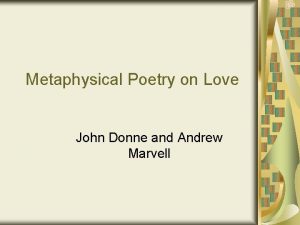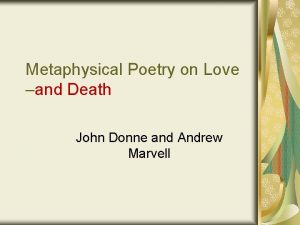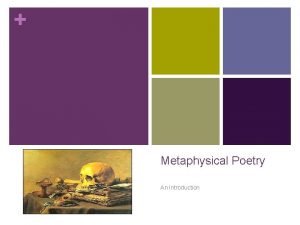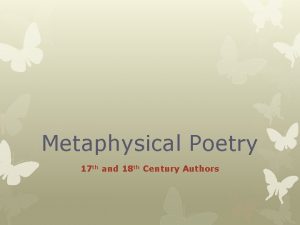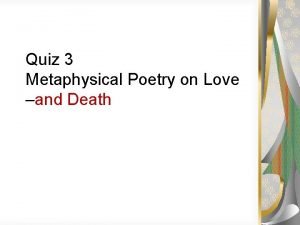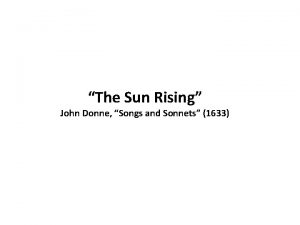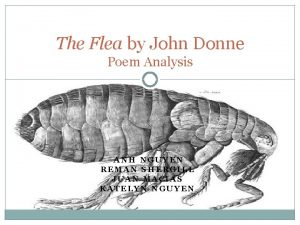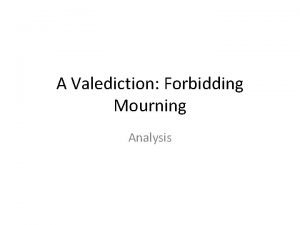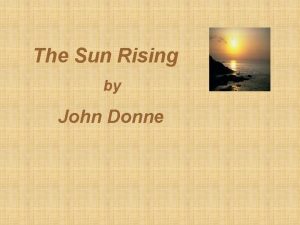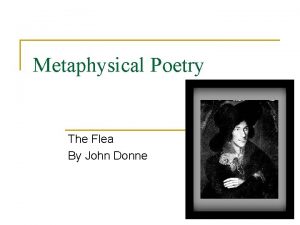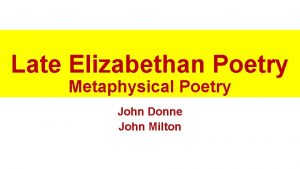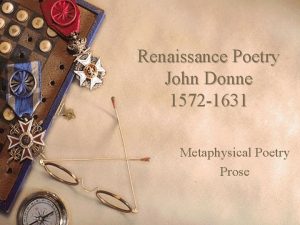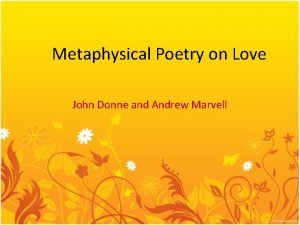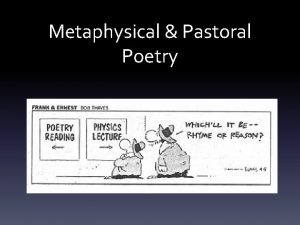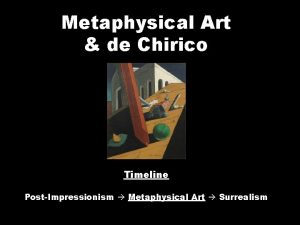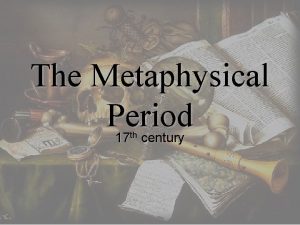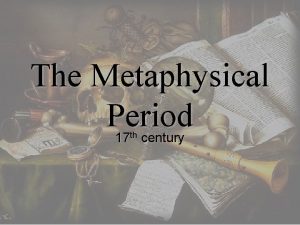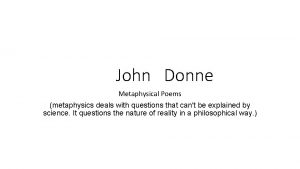Lecture 14 John Donne and metaphysical poetry Deanship























- Slides: 23


Lecture 14 John Donne and metaphysical poetry ﻋﻤﺎﺩﺓ ﺍﻟﺘﻌﻠﻴﻢ ﺍﻹﻛﺘﺮﻭﻧﻲ ﻭﺍﻟﺘﻌﻠﻢ ﻋﻦ ﺑﻌﺪ Deanship of E-Learning and Distance Education 2 [ ] ﺟﺎﻣﻌﺔ ﺍﻟﻤﻠﻚ ﻓﻴﺼﻞ King Faisal University

John Donne and metaphysical poetry: v There is no real precedent in English for Donne’s love lyrics, either for the sustained variety of verse forms or for the comparably great variety of tone and implied occasion; and though Donne’s style grows out of a general sixteenthcentury aesthetic of “conceited verses, ” his particular way of tight, combative argumentation, demanding the relentless close attention of his reader, takes that aesthetic to a dramatically new level. v At best, that argumentativeness is of a piece with the subject matter: love as battle of wits, either between the lovers themselves, or between the lovers and the world around them. … Donne writes some of the classic poems … that affirm love with a pitch of hyperbole: radically transformative, unshakeably enduring, with the capacity of rendering everything else irrelevant. ﻋﻤﺎﺩﺓ ﺍﻟﺘﻌﻠﻴﻢ ﺍﻹﻛﺘﺮﻭﻧﻲ ﻭﺍﻟﺘﻌﻠﻢ ﻋﻦ ﺑﻌﺪ Deanship of E-Learning and Distance Education [ ] ﺟﺎﻣﻌﺔ ﺍﻟﻤﻠﻚ ﻓﻴﺼﻞ King Faisal University

Metaphysical Poets v The name given to a diverse group of 17 th century English poets whose work is notable for its ingenious (clever) use of intellectual and theological concepts in surprising CONCEITS, strange PARADOXES, and far-fetched IMAGERY. v The leading metaphysical poet was John Donne, whose colloquial, argumentative abruptness of rhythm and tone distinguishes his style from the CONVENTIONS of Elizabethan love-lyrics. Other poets to whom the label is applied include Andrew Marvell, Abraham Cowley, John Cleveland, and the predominantly religious poets George Herbert, Henry Vaughan, and Richard Crashaw. v In the 20 th century, T. S. Eliot and others revived their reputation, stressing their quality of WIT, in the sense of intellectual strenuousness and flexibility rather than smart humour. The term metaphysical poetry usually refers to the works of these poets, but it can sometimes denote any poetry that discusses metaphysics, that is, the philosophy of knowledge and existence. ﻋﻤﺎﺩﺓ ﺍﻟﺘﻌﻠﻴﻢ ﺍﻹﻛﺘﺮﻭﻧﻲ ﻭﺍﻟﺘﻌﻠﻢ ﻋﻦ ﺑﻌﺪ Deanship of E-Learning and Distance Education [ ] ﺟﺎﻣﻌﺔ ﺍﻟﻤﻠﻚ ﻓﻴﺼﻞ King Faisal University

A Valediction: Forbidding Mourning As virtuous men pass mildly away And whisper to their souls to go, Whilst some of their sad friends do say, The breath goes now, and some say, No, So let us melt and make no noise, 5 No tear-floods nor sigh-tempests move; Twere profanation of our joys (not sacred) To tell the laity our love. (common) ﻋﻤﺎﺩﺓ ﺍﻟﺘﻌﻠﻴﻢ ﺍﻹﻛﺘﺮﻭﻧﻲ ﻭﺍﻟﺘﻌﻠﻢ ﻋﻦ ﺑﻌﺪ Deanship of E-Learning and Distance Education [ ] ﺟﺎﻣﻌﺔ ﺍﻟﻤﻠﻚ ﻓﻴﺼﻞ King Faisal University

Moving of the earth brings harms and fears, Men reckon what it did and meant; (think) 10 But trepidation of the spheres, (anxiety) Though greater far, is innocent. Dull sublunary lovers’ love (Whose soul is sense) cannot admit Absence, because it doth remove 15 Those things which elemented it; But we, by a love so much refined That ourselves know not what it is, Interassurèd of the mind, Care less eyes, lips, and hands to miss. 20 Our two souls, therefore, which are one, Though I must go, endure not yet A breach, but an expansion, ﻋﻤﺎﺩﺓ ﺍﻟﺘﻌﻠﻴﻢ ﺍﻹﻛﺘﺮﻭﻧﻲ ﻭﺍﻟﺘﻌﻠﻢ ﻋﻦ ﺑﻌﺪ Deanship of E-Learning and Distance Education [ ] ﺟﺎﻣﻌﺔ ﺍﻟﻤﻠﻚ ﻓﻴﺼﻞ King Faisal University

Like gold to airy thinness beat. If they be two, they are two so As stiff twin compasses are two. Thy soul, the fixed foot, makes no show To move, but doth if the other do; And though it in the center sit, Yet when the other far doth roam, It leans and harkens after it, And grows erect as that comes home. Such wilt thou be to me, who must Like the other foot obliquely run; Thy firmness draws my circle just, And makes me end where I begun ﻋﻤﺎﺩﺓ ﺍﻟﺘﻌﻠﻴﻢ ﺍﻹﻛﺘﺮﻭﻧﻲ ﻭﺍﻟﺘﻌﻠﻢ ﻋﻦ ﺑﻌﺪ Deanship of E-Learning and Distance Education [ ] 25 30 ﺟﺎﻣﻌﺔ ﺍﻟﻤﻠﻚ ﻓﻴﺼﻞ King Faisal University

“A Valediction: forbidding Mourning” v The speak explains that he is forced to spend time apart from his lover, (his wife) but before he leaves, he tells her that their farewell should not become anoccasion for mourning and sorrow. In the same way that virtuous men die mildly and without complaint, he says, so they should leave without “tear-floods” and “sightempests, ” for to publicly announce their feelings in such a way would profane their love. The speaker says that when the earth moves, it brings “harms and fears, ” but when the spheres experience “trepidation, ” though the impact is greater, it is also innocent (simple). The love of “dull sublunary lovers” can not survive separation, but it removes that which constitutes the love itself; but the love he shares with his beloved is so refined and “Inter-assured of the mind” that they need not worry about missing “eyes, lips, and hands. ” ﻋﻤﺎﺩﺓ ﺍﻟﺘﻌﻠﻴﻢ ﺍﻹﻛﺘﺮﻭﻧﻲ ﻭﺍﻟﺘﻌﻠﻢ ﻋﻦ ﺑﻌﺪ Deanship of E-Learning and Distance Education [ ] ﺟﺎﻣﻌﺔ ﺍﻟﻤﻠﻚ ﻓﻴﺼﻞ King Faisal University

v Though he must go, their souls are still one, and, therefore, they are not enduring a breach (a cut), they are experiencing an “expansion”; in the same way that gold can be stretched by beating it “to aery thinness, ” the soul they share will simply stretch to take in all the space between them. If their souls are separate, he says, they are like the feet of compass: v His lover’s soul is the fixed foot in the center, and his is the foot that moves around it. The firmness of the center foot makes the circle that the outer foot draws perfect: “Thy firmness makes my circle just, / And makes me end, where I begun. ” ﻋﻤﺎﺩﺓ ﺍﻟﺘﻌﻠﻴﻢ ﺍﻹﻛﺘﺮﻭﻧﻲ ﻭﺍﻟﺘﻌﻠﻢ ﻋﻦ ﺑﻌﺪ Deanship of E-Learning and Distance Education [ ] ﺟﺎﻣﻌﺔ ﺍﻟﻤﻠﻚ ﻓﻴﺼﻞ King Faisal University

Form v The nine stanzas of this Valediction are quite simple compared to many of Donne’s poems, which make use of strange metrical patterns overlaid jarringly on regular rhyme schemes. Here, each four-line stanza is quite unadorned (simple and plain) , with an ABAB rhyme scheme and an iambic tetrameter. v “A Valediction: forbidding Mourning” is one of Donne’s most famous and simplest poems and also probably his most direct statement of his ideal of spiritual love. For all his sensuality in poems, such as “The Flea, ” Donne professed a devotion to a kind of spiritual love that transcended the merely physical. Here, anticipating a physical separation from his beloved, he invokes the nature of that spiritual love to ward off (keep away) the “tear-floods” and “sigh-tempests” that might otherwise attend on their farewell. ﻋﻤﺎﺩﺓ ﺍﻟﺘﻌﻠﻴﻢ ﺍﻹﻛﺘﺮﻭﻧﻲ ﻭﺍﻟﺘﻌﻠﻢ ﻋﻦ ﺑﻌﺪ Deanship of E-Learning and Distance Education [ ] ﺟﺎﻣﻌﺔ ﺍﻟﻤﻠﻚ ﻓﻴﺼﻞ King Faisal University

v The poem is essentially a sequence of metaphors and comparisons, each describing a way of looking at their separation that will help them to avoid the mourning (showing sadness) forbidden by the poem’s title. v First, the speaker says that their farewell should be as mild as the uncomplaining deaths of virtuous men, for to weep would be “profanation of our joys. ” Next, the speaker compares harmful “Moving of th’ earth” to innocent “trepidation of the spheres, ” equating the first with “dull sublunary lovers’ love” and the second with their love, “Inter-assured of the mind. ” ﻋﻤﺎﺩﺓ ﺍﻟﺘﻌﻠﻴﻢ ﺍﻹﻛﺘﺮﻭﻧﻲ ﻭﺍﻟﺘﻌﻠﻢ ﻋﻦ ﺑﻌﺪ Deanship of E-Learning and Distance Education [ ] ﺟﺎﻣﻌﺔ ﺍﻟﻤﻠﻚ ﻓﻴﺼﻞ King Faisal University

v Like the rumbling (making deep sound) earth, the dull sublunary (sublunary meaning literally beneath the moon and also subject to the moon) lovers are all physical, unable to experience separation without losing the sensation that comprises and sustains their love. But the spiritual lovers “Care less, eyes, lips, and hands to miss, ” because, like the trepidation (vibration) of the spheres (the concentric globes that surrounded the earth in ancient astronomy), their love is not wholly physical. Also, like the trepidation of the spheres, their movement will not have the harmful consequences of an earthquake. v The speaker then declares that, since the lovers’ two souls are one, his departure will simply expand the area of their unified soul, rather than cause a rift (cut) between them. If, however, their souls are “two” instead of “one”, they are as the feet of a drafter’s compass, connected, with the center foot fixing the orbit of the outer foot and helping it to describe a perfect circle. The compass (the instrument used for drawing circles) is one of Donne’s most famous metaphors, and it is the perfect image to encapsulate the values of Donne’s spiritual love, which is balanced, symmetrical, intellectual, serious, and beautiful in its polished simplicity. ﻋﻤﺎﺩﺓ ﺍﻟﺘﻌﻠﻴﻢ ﺍﻹﻛﺘﺮﻭﻧﻲ ﻭﺍﻟﺘﻌﻠﻢ ﻋﻦ ﺑﻌﺪ Deanship of E-Learning and Distance Education [ ] ﺟﺎﻣﻌﺔ ﺍﻟﻤﻠﻚ ﻓﻴﺼﻞ King Faisal University

v Like many of Donne’s love poems (including “The Sun Rising” and “The Canonization”), “A Valediction: forbidding Mourning” creates a dichotomy between the common love of the everyday world and the uncommon love of the speaker. Here, the speaker claims that to tell “the laity, ” or the common people, of his love would be to profane its sacred nature, and he is clearly contemptuous of the dull sublunary love of other lovers. The effect of this dichotomy is to create a kind of emotional aristocracy that is similar in form to the political aristocracy with which Donne has had painfully bad luck throughout his life and which he commented upon in poems, such as “The Canonization”: This emotional aristocracy is similar in form to the political one but utterly opposed to it in spirit. v Few in number are the emotional aristocrats who have access to the spiritual love of the spheres and the compass; throughout all of Donne’s writing, the membership of this elite never includes more than the speaker and his lover—or at the most, the speaker, his lover, and the reader of the poem, who is called upon to sympathize with Donne’s romantic plight (sad or desperate predicament). ﻋﻤﺎﺩﺓ ﺍﻟﺘﻌﻠﻴﻢ ﺍﻹﻛﺘﺮﻭﻧﻲ ﻭﺍﻟﺘﻌﻠﻢ ﻋﻦ ﺑﻌﺪ Deanship of E-Learning and Distance Education [ ] ﺟﺎﻣﻌﺔ ﺍﻟﻤﻠﻚ ﻓﻴﺼﻞ King Faisal University

Further comment : v "A Valediction: Forbidding Mourning" shows many features associated with seventeenthcentury metaphysical poetry in general, and with Donne's work in particular. Donne's contemporary, the English writer Izaak Walton, tells us the poem dates from 1611, when Donne, about to travel to France and Germany, wrote for his wife this valediction, or farewell speech. Like most poetry of Donne's time, it did not appear in print during the poet's lifetime. The poem was first published in 1633, two years after Donne's death, in a collection of his poems called Songs and Sonnets. Even during his life, however, Donne's poetry became well known because it circulated privately in manuscript and handwritten copies among literate Londoners. v The poem tenderly comforts the speaker's lover at their temporary parting, asking that they separate calmly and quietly, without tears or protests. The speaker justifies the desirability of such calmness by developing the ways in which the two share a holy love, both physical and spiritual in nature. Donne's celebration of earthly love in this way has often been referred to as the "creed of love. " ﻋﻤﺎﺩﺓ ﺍﻟﺘﻌﻠﻴﻢ ﺍﻹﻛﺘﺮﻭﻧﻲ ﻭﺍﻟﺘﻌﻠﻢ ﻋﻦ ﺑﻌﺪ Deanship of E-Learning and Distance Education [ ] ﺟﺎﻣﻌﺔ ﺍﻟﻤﻠﻚ ﻓﻴﺼﻞ King Faisal University

v Donne treats their love as sacred, elevated above that of ordinary earthly lovers. He argues that because of the confidence their love gives them, they are strong enough to endure a temporary separation. In fact, he discovers ways of suggesting, through metaphysical conceit, that the two of them either possess a single soul and so can never really be divided, or have twin souls permanently connected to each other. v A metaphysical conceit is an extended metaphor or simile in which the poet draws an ingenious (clever) comparison between two very unlike objects. "A Valediction: Forbidding Mourning" ends with one of Donne's most famous metaphysical conceits, in which he argues for the lovers' closeness by comparing their two souls to the feet of a drawing compass—a simile that would not typically occur to a poet writing about his love! ﻋﻤﺎﺩﺓ ﺍﻟﺘﻌﻠﻴﻢ ﺍﻹﻛﺘﺮﻭﻧﻲ ﻭﺍﻟﺘﻌﻠﻢ ﻋﻦ ﺑﻌﺪ Deanship of E-Learning and Distance Education [ ] ﺟﺎﻣﻌﺔ ﺍﻟﻤﻠﻚ ﻓﻴﺼﻞ King Faisal University

v The compass image suggests a connection between the lovers even as they are apart. Yet Donne ingeniously finds further meanings. He considers the difference between a central, “fixed” foot at “home” and a roaming, “obliquely” moving foot. He suggests ideas of desire: leans, ” and “hearkens, ”. ”He concludes with an idea of love as the perfect (“just”) circle that ends where it began. ﻋﻤﺎﺩﺓ ﺍﻟﺘﻌﻠﻴﻢ ﺍﻹﻛﺘﺮﻭﻧﻲ ﻭﺍﻟﺘﻌﻠﻢ ﻋﻦ ﺑﻌﺪ Deanship of E-Learning and Distance Education [ ] ﺟﺎﻣﻌﺔ ﺍﻟﻤﻠﻚ ﻓﻴﺼﻞ King Faisal University

The occasion of the poem seems to be parting. Walton asserts that the poem was penned in 1611 when Donne was planning for a tour of France with the Drury family. Parting here is pictured as a miniature enactment of death. The poet refers to an untheatrical form of death where the dying mildly give away to death. Sometimes death may be anticipated, nevertheless at times it comes as an intruder in spite of one saying : ”No. ” So let us melt, and make no noise, No tear-floods, nor sigh-tempests move ; 'Twere profanation of our joys To tell the laity our love. ﻋﻤﺎﺩﺓ ﺍﻟﺘﻌﻠﻴﻢ ﺍﻹﻛﺘﺮﻭﻧﻲ ﻭﺍﻟﺘﻌﻠﻢ ﻋﻦ ﺑﻌﺪ Deanship of E-Learning and Distance Education [ ] ﺟﺎﻣﻌﺔ ﺍﻟﻤﻠﻚ ﻓﻴﺼﻞ King Faisal University

v The term ‘melt’ may also signify a change in physical state. Just as the dead body decays, the bond between both of the lovers shall dissolve. He introduces the three elements-air, water and earth to show that these elements constitute the circle of life and death on earth. The air is referred to in ‘sigh-tempests’, water in ‘tearfloods’ and earth with reference to earthquakes. The poet bringing on all these natural calamities seems to imply their parting is of less consequence as compared to these. Moreover, as compared to such dreaded catastrophes, my parting shall not cause any harm to our love. ﻋﻤﺎﺩﺓ ﺍﻟﺘﻌﻠﻴﻢ ﺍﻹﻛﺘﺮﻭﻧﻲ ﻭﺍﻟﺘﻌﻠﻢ ﻋﻦ ﺑﻌﺪ Deanship of E-Learning and Distance Education [ ] ﺟﺎﻣﻌﺔ ﺍﻟﻤﻠﻚ ﻓﻴﺼﻞ King Faisal University

v The speaker states that earthquakes may be dreadful, but not the oscillation of the heavenly spheres. This is, because the consequences of the earthquakes can be apprehended (understood), but the effect of the oscillation of the heavenly spheres cannot be perceived. What the poet means to say is that -only things that can be apprehended should be worried about. He advises his lady-love not to fret (worry) too much about their separation. v Ethereal lovers completely testify to spiritual love. Therefore their physical proximity(closeness in space and time) /absence is of no consequence. The soul is placed above its elemental form, the physical form. But we by a love so much refined, That ourselves know not what it is, Inter-assurèd of the mind, Care less, eyes, lips and hands to miss. ﻋﻤﺎﺩﺓ ﺍﻟﺘﻌﻠﻴﻢ ﺍﻹﻛﺘﺮﻭﻧﻲ ﻭﺍﻟﺘﻌﻠﻢ ﻋﻦ ﺑﻌﺪ Deanship of E-Learning and Distance Education [ ] ﺟﺎﻣﻌﺔ ﺍﻟﻤﻠﻚ ﻓﻴﺼﻞ King Faisal University

v The poet asserts that their love is so pure that it can be apprehended through the senses, and this does not necessarily require the sensory perceptions. The poet then goes to elaborate in the next stanza that their souls are one, and therefore do not see their breach as a gap, but rather recognize it as an expansion. Donne makes use of the image of gold beaten into airy thinness; likewise earthly love is transformed into divine love. v The poet likens the twin legs of a compass to the lovers' sense of union during absence. This an apt example of metaphysical wit, which yokes dissimilar things together. The two hands of the compass though separated for a small fraction of time were destined to always meet. Also, the compass points the direction to others, suggesting that they were a paradigm for others to follow. Again, a compass drew a circle that was the shape of perfection, according to Ptolemy. By utilizing this shape Donne proves that their love is perfect, physically and spiritually. ﻋﻤﺎﺩﺓ ﺍﻟﺘﻌﻠﻴﻢ ﺍﻹﻛﺘﺮﻭﻧﻲ ﻭﺍﻟﺘﻌﻠﻢ ﻋﻦ ﺑﻌﺪ Deanship of E-Learning and Distance Education [ ] ﺟﺎﻣﻌﺔ ﺍﻟﻤﻠﻚ ﻓﻴﺼﻞ King Faisal University

v Besides, the two hands are incomplete without each other. With reference to the compass, it is their separation that actually defines them. It is the firmness of one foot that actually renders the other perfect. It makes him end at where he begunand therefore the circle (of their divine love) becomes complete. This divine circle may also refer to a halo that their divine status has endowed (gave) them. v conceit : a metaphor used to build an analogy between two things or situations not naturally, or usually, comparable. Conceits can be compact or extended. A familiar example of a more elaborate conceit occurs in John Donne’s “A Valediction: Forbidding Mourning. ” Like most conceits, this one is structural and lingering rather than momentary. Donne compares, at some length, two temporarily parted lovers to the two pointed legs of a compass, which move and hearken (listen) in tandem. ﻋﻤﺎﺩﺓ ﺍﻟﺘﻌﻠﻴﻢ ﺍﻹﻛﺘﺮﻭﻧﻲ ﻭﺍﻟﺘﻌﻠﻢ ﻋﻦ ﺑﻌﺪ Deanship of E-Learning and Distance Education [ ] ﺟﺎﻣﻌﺔ ﺍﻟﻤﻠﻚ ﻓﻴﺼﻞ King Faisal University

v paradox : A paradox is a contradiction that somehow proves fitting or true. As such, it is a central device of seventeenth-century literature, in the work of writers like John Donne, Andrew Marvell, George Herbert, and Thomas Browne. ﻋﻤﺎﺩﺓ ﺍﻟﺘﻌﻠﻴﻢ ﺍﻹﻛﺘﺮﻭﻧﻲ ﻭﺍﻟﺘﻌﻠﻢ ﻋﻦ ﺑﻌﺪ Deanship of E-Learning and Distance Education [ ] ﺟﺎﻣﻌﺔ ﺍﻟﻤﻠﻚ ﻓﻴﺼﻞ King Faisal University

 Metaphysical poetry
Metaphysical poetry John donne poem
John donne poem John donne as a metaphysical poet
John donne as a metaphysical poet Define metaphysical poetry
Define metaphysical poetry Conceit definition literature
Conceit definition literature Metaphysical conceit in death be not proud
Metaphysical conceit in death be not proud Metaphysical poetry introduction
Metaphysical poetry introduction Metaphysical poetry characteristics
Metaphysical poetry characteristics Metaphysical poetry characteristics
Metaphysical poetry characteristics Metaphysical poetry quiz
Metaphysical poetry quiz The sun rising john donne analysis
The sun rising john donne analysis The legacy john donne
The legacy john donne The flea by john donne analysis
The flea by john donne analysis John donne mappa concettuale
John donne mappa concettuale A valediction forbidding mourning structure
A valediction forbidding mourning structure A valediction forbidding mourning analysis stanza by stanza
A valediction forbidding mourning analysis stanza by stanza John donne the ecstacy
John donne the ecstacy Purpled thy nail
Purpled thy nail Love's diet analysis
Love's diet analysis The broken heart john donne analysis
The broken heart john donne analysis John donne (1572-1631)
John donne (1572-1631) John donne holy sonnet 11
John donne holy sonnet 11 She's all states and all princes i
She's all states and all princes i The sun rising'' as a metaphysical poem
The sun rising'' as a metaphysical poem



